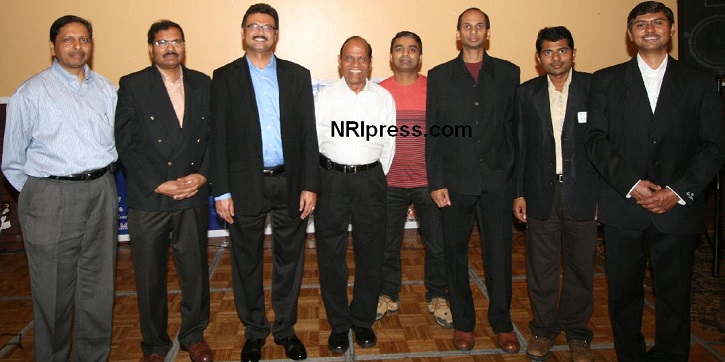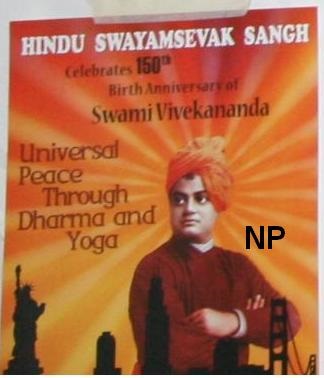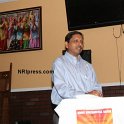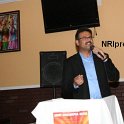 |
Hindu Swayamsevak Sangh, HSS Celebrate Swami Vivekananda 150th Birth Anniversary in LA
Los Angeles, March 15, 2013
Anil Parekh/// Ramesh/Gary Singh
Hindu Swayamsevak Sangh (HSS) celebrated Swami Vivekananda 150th Birth Anniversary on March 15, 2013 at Haveli India Cuisine, Artesia. More than 100 Community leaders and invited guest attended INFORMATIONAL DINNER EVENT

All guests enjoyed the Power point Presentation and gained valuable insight into the activities planned for Swami Vivekananda 150th Birth Anniversary. Swami ji’s advancement of Dharma in the modern era uniquely resonates with Hindu-Americans. The ideas propagated by him, such as Yoga, Karma, and the spiritual oneness of humanity, have a growing appeal in America. This has also led to the popularity of practices such as Yoga, Ayurveda, and meditation, and more and more American are getting inclined to lead a healthy food and healthy lifestyle.

HSS, Hindu Swayamsevak Sangh USA is commemorating Swami Vivekananda’s150th birth anniversary in 2013 through various "Dharmik" programs and events. The festival will promote wholesome and spiritual living, and will have participation from various for-profit and non-profit Dharmik and Yoga organizations in September. The event will be open for all practicing Hindus (Indian and non Indian), yoga performers and mainstream public.
HSS, Hindu Swayamsevak Sangh USA is a voluntary, non-profit, social and cultural organization. Sangh is inspired by the idea that the whole world is one family and conducts activities across the United States in order to spread this message widely. Sangh in the United States started in 1989 and today has over 140 weekly meeting centers (shakhas) across the country.
HSS shakhas in Texas mobilized hundreds of volunteers to assist and provide shelters across Texas during the Katrina disaster. We encourage maintaining Hindu cultural identity in harmony with the larger community. HSS publishes a quarterly magazine where children contribute much of the content.Within two years of its launch, the magazine has more than 2500 subscribers which speak of its popularity among the kids. International subscriptions are available in the United Kingdom, Canada and Australia.
HSS's aim to organize the Hindu community in order to preserve, practice and promote Hindu ideals and values. HSS conducts structured programs of regular athletic and academic activities to develop strong character and leadership skills in its members (known as swayamsevaks for men and sevikas for women), emphasizing values such as self-discipline, self-confidence and a spirit of selfless service (seva) for humanity. .
Vivekananda was born as Narendranath in the Datta family of Calcutta, India, on January 12, 1863 and was one of the nine siblings. Narendra's mother was a pious woman and was fascinated by the wandering ascetics and monks. He had a great interest in the Hindu scriptures such as the Vedas, the Bhagavad Gita, the Ramayana, the Mahabharata. He took part in physical exercise, sports, organisational activities and got traing in Indian classical music.
- In 1879, he passed the entrance examination from the Presidency College and studied western logic, western philosophy and history of European nations in the General Assembly's Institution
- In 1881, he passed the Fine Arts examination and he completed a Bachelor of Arts degree in 1884
Narendra became fascinated with the evolutionism of Herbert Spencer and had correspondence with him; he translated Spencer's book Education (1861) into Bengali. Alongside his study of Western philosophers, he was thoroughly acquainted with Indian Sanskrit scriptures and many Bengali works. Dr. William Hastie, principal of General Assembly's Institution, wrote, "Narendra is really a genius."
Narendra's meeting with Ramakrishna in November 1881 proved to be a turning point in Narendra's life
- In 1884, His father's death in Narendra's family bankrupt. Unable to find employment and facing poverty, Narendra questioned God's existence. During this time, Narendra found solace in Ramakrishna, and his visits to Dakshineswar increased. Narendra gradually became ready to renounce everything for the sake of realising God. In time, Narendra accepted Ramakrishna as his guru. Ramakrishna died in 1886 at his garden house in Cossipore
- In January 1887, Narendra and eight other disciples took formal monastic vows. Narendra took the name of Swami Bibidishananda. Later he was given the name Vivekananda by Ajit Singh, the Maharaja of Khetri.
- In 1888, Vivekananda left the monastery as a Parivrâjaka, the Hindu religious life of a wandering monk, "without fixed abode, without ties, independent and strangers wherever they go with water pot and his two favourite books: Bhagavad Gita and The Imitation of Christ
- In 1890, accompanied by the fellow monk Swami Akhandananda (also a disciple of Ramakrishna), Vivekananda visited the Himalayas
- In 1991, he visited historical sites at Delhi, Rajputana and Ajmer where he visited the palace of Akbar. At Mount Abu, friendship with Maharaja Ajit Singh of Khetri was started and developed through their mutual interest in significant spiritual and secular topics. At Khetri, he studied Mahābhāṣya on sutras of Panini. he proceeded towards Maharastra and Ahmedabad where, he completed his studies of Islamic and Jain culture.
- In 1992, he met Thakur Saheb Jaswant Singh, who had himself been to England and America. From Thakur Saheb, he first got the idea of going to the West to preach Vedanta. He spent few days in the Rachol Seminary, the oldest convent of Goa, where rare religious manuscripts and printed works in Latin were preserved. There, he studied Christian theological works. He visited Madurai, where he met the Raja of Ramnad, Bhaskara Sethupathi, to whom he had a letter of introduction. The Raja became his disciple and urged him to go to the Parliament of Religions at Chicago
- 1893-1997: Vivekananda visited Japan, China, Canada and reached at Chicago in July, 1893. On September 11, 1893, Parliament of the World's Religions was opened at the Art Institute of Chicago. He gave his first brief speech. on behalf of India and Hinduism. He began his speech with, "Sisters and brothers of America!. To these words he got a standing ovation from a crowd of seven thousand, which lasted for two minutes. Dr. Barrows, the president of the Parliament said, "India, the Mother of religions was represented by Swami Vivekananda, the Orange-monk who exercised the most wonderful influence over his auditors. The American newspapers reported Vivekananda as "the greatest figure in the parliament of religions" and "the most popular and influential man in the parliament He spoke several more times at the Parliament on topics related to Hinduism, Buddhism and harmony of religions. The parliament ended on 27 September 1893. All his speeches at the Parliament had the common theme of universality, and emphasised religious tolerance
- Vivekananda spent nearly two years lecturing in various parts of eastern and central United States, mostly in Chicago, Detroit, Boston, and New York
- In 1894, he founded the "Vedanta Society of New York"
- 1895-1896, he travelled to England twice. He met Margaret Elizabeth Noble, Paul Deussen in Germany,Max Müller, a noted Indologist from Oxford University who wrote Ramakrishna's first biography in the West. He declined academic positions in two American universities-one for the chair of Eastern Philosophy at Harvard University and another similar position at Columbia University because such duties would conflict with his commitment as a monk
- Vivekananda attracted several followers and admirers in the US and Europe, such as Josephine MacLeod, William James, Josiah Royce, Robert G. Ingersoll, Nikola Tesla, Lord Kelvin, Harriet Monroe, Ella Wheeler Wilcox, Sarah Bernhardt, Emma Calvé, and Professor Hermann Ludwig Ferdinand von Helmholtz.
- Vivekananda set his work back in India in motion by sending money to his brother monks. He told them "Go from door to door amongst the poor and lower classes of the town of Khetri and teach them religion."
- December 30,1896, he set sail for India from the Port of Naples by visiting France and Italy. The ship arrived in Colombo on January 15, 1897, Vivekananda received an ecstatic welcome and he gave his first public speech in the East, India, the Holy Land. His speeches had influence on the contemporaneous and subsequent Indian leaders such as Mahatma Gandhi, Bipin Chandra Pal, Balgangadhar Tilak and Netaji Subhas Chandra Bose.
- On 1 May 1897 at Calcutta, Vivekananda founded the Ramakrishna Mission, the organ for social service
- June 1899, Vivekananda left for the West for the second time despite his declining health. He established the Vedanta societies at San Francisco, New York and also founded "Shanti Ashrama" at California.
- He attended the Congress of Religions in Paris in 1900.His lectures in Paris dwelt on worship of Linga and authenticity of the Gita. From Paris he visited Brittany, Vienna, Istanbul, Athens and Egypt. He returned to Calcutta on December 09, 1900. He settled at Belur Math from where he continued to coordinate the works of Ramakrishna Mission and Math, and also the works in England and America.
- He was unable to join the Congress of Religions in 1901 in Japan due to deteriorating health.
- On 4 July 1902, Rupture of blood vessels in the brain was reported as a possible cause of the death.
Vivekananda believed:
- A country's future depends on its people; his teachings focused on the development of the mass.
- He wanted “to set in motion a machinery which will bring noblest ideas to the doorstep of even the poorest and the meanest.
- The essence of Hinduism was best expressed in the Vedanta philosophy, based on the interpretation of Adi Shankara.

|




